Today’s tip is to help your hips and hamstrings
The Hip Joint
The hip is a ball and socket joint with the head of the femur forming the ball and the pelvis the socket. This design allows for the greatest range of motion in the body next to the shoulder joint (which is also a ball and socket joint by the way – listen to episode 88 about shoulders if you missed it).
The hip has 3 main movements:
- Flexion and Extension – Moving the leg backward and forward.
- Abduction and Adduction – Moving the leg out to the side and in towards the other leg.
- Rotation – Moving the foot left and right
Above the hips lie the muscles of your core which, when activated, provide stability. Below the pelvis are muscles that free up the hips and allow for lower body movement like quadriceps, hamstrings, hip flexors and glutes to name only a few.
Tight Hips
Unfortunately prolonged sitting can cause these muscles around the joint to become tight (for example the hamstrings remain flexed and shorten) which can result in reduced mobility and potentially pain.
Tightness in the hip flexors and hamstrings can alter the alignment in the pelvis which affects the way the spine lines up causing low back pain. In fact tight hip flexors can cause all sorts of problems including:
- Poor posture
- Anterior pelvic tilt causing the belly to look a little larger (regardless of weight)
- A higher risk of injury
- Even an increase in anxiety levels
In addition, tight hips can lead to muscle imbalances. When the muscles aren’t working like they should, other muscles overcompensate to pick up the slack.
Not only does this greatly increase injury risk, but it also means that we will be unable to perform at our best during any activity we want to take on.
Now, acute or chronic pain in these areas can be a sign of a medical concern which should be addressed by your physician or health care professional. So check with them before making any big changes in your routine.
If the root of the pain is due to tight hips & reduced mobility, the tips to follow may be helpful.
Improving Hip Mobility & Stability
So what can you do to help those hips and hamstrings, loosen things up and improve or prevent pain?
Sit Less
Well, obviously the desk job is a killer on the hips. In 2019 the average adult american was sitting for 6 ½ hours per day while teens 12-19 sat for 8 hours per day. Thanks to remote work and remote school, I’m sure those numbers are much higher these days.
A standing desk is a great change but if this isn’t an option, setting a little reminder or alarm to get you up and moving every 15 minutes or so is your next best bet. You don’t necessarily need to even leave your desk, just stand up, do a few gentle stretches (more on that in a sec) then sit back down.
Done consistently over time, this strategy will make a huge difference in your life. Trust me!
Mobility & Flexibility
Next, regardless of whether or not you are able to reduce the amount of sitting you do, stretching and mobility exercises are an important addition to your day.
Hip Flexor Stretch
Hip Flexors shorten and tighten due to prolonged sitting, so start with a kneeling hip flexor stretch.
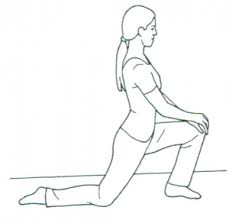
- From a kneeling position place the left knee on the floor (or stretch mat) directly under the left hip, and place the right foot in front of the right hip so that the right knee is directly over the right ankle and the right hip is in a position of ninety (90) degrees. Place both hands gently on the right thigh to help maintain a straight, tall spine.
- Without arching your low back, “brace” (engage your abdominal/core muscles) to stiffen your spine and keep your pelvis level (and stable). Lean forward into your right hip while keeping your left knee pressed into the ground, do not allow your pelvis to rotate to the anterior (forward). To increase the stretch to the left hip flexors, squeeze and contract the glute muscles of your left hip. Hold for 30-90 seconds then repeat on the other leg
Hip Rotator Stretch
You can also stretch out the hip rotators at your desk performing both the internal rotator stretch and external rotator stretch.

Internal Rotator Stretch
- To stretch the left side in sitting cross your left leg over the right so that your left ankle is laying across your right thigh.
- Put your left hand on your left thigh and gently press down until you feel resistance.
- Then tilt forward at the hips slowly as you exhale. Remember to keep your chest up and your back straight. Don’t allow yourself to hunch forward or lose the normal lordosis (inward curvature) in your lower back.
- Hold this position for 30-60 seconds then repeat on the other leg.
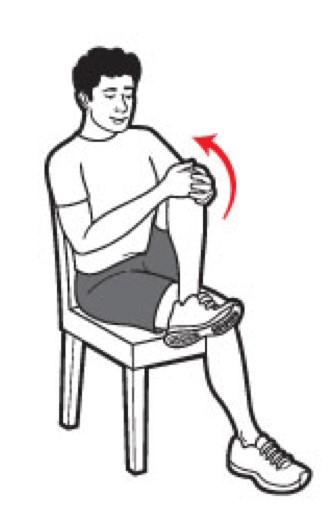
External Hip Rotator Stretch
- Cross your left leg over the right so the left ankle sits just past the right thigh.
- Grab your left knee with both hands and pull it back and to the right. If it helps, think of it as pulling your knee towards your right shoulder.
- Tilt forward at the hips slowly. Make sure your chest is up, your back is straight, and make certain you aren’t hunching.
- Hold this position for 30 seconds.
Hamstring Stretch
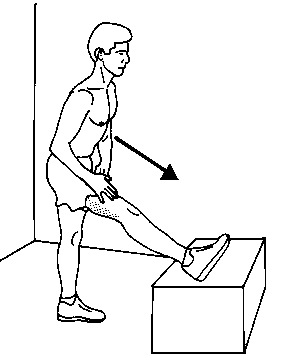
- Prop your right leg up on a bench or chair, making sure to keep it fully extended.
- Ensure that your left foot is pointing straight forward towards the bench & that your hips are square to the bench
- While keeping your core tight, lean forward slightly until you feel a stretch in your hamstrings.
- Hold this position for 30-90 seconds then switch legs.
Hip Mobility Exercises
Next you will want to work on improving mobility in the hips. Mobility exercises are different from stretching or flexibility exercises. Mobility is the ability to move a limb freely through its full range of motion (mobility exercises are dynamic or involve slow, controlled movement). Flexibility exercises are static (they are held for a short period of time – 30-90 seconds and are focused on increasing the length of the muscle.
90/90 Hip Rotation
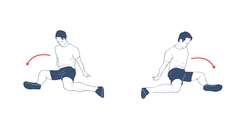
- Sit down in the 90-90 position, lead leg directly in front of you with knee bent to 90 degrees. Your trail leg should be out to your side creating another right angle at your hip, with the knee also bent to 90 degrees so the sole of your trail leg is facing backwards.
- Lean forward over your lead leg while keeping a high chest feeling a deep stretch in the hip. Hold here for a few seconds. Ease out of the position and turn to face your trail leg, you may need to put your arms back to support this position. If you experience any pinching pain in this position, please see a professional physical therapist to make sure there is nothing wrong.
- From this position, keeping your weight on your trail leg, rotate the hip, raising your knee up into the air while pivoting on the ball of your foot. Keep your lead leg down as long as possible, opening up your hips as much as possible.
- Continue the rotation, turning to your once trail leg until your feel their roles swap, your trail leg now becomes your lead leg and your lead leg now your trail leg, you should gently fall into the 90-90 position facing in the opposite direction.
Hip CARs
Hip CARs ( or ‘controlled articular rotations’) is an exercise that takes your hip joint through its full range of motion. It’s effective at increasing the range of motion while improving hip function, and maintaining the overall health and integrity of the hip joint.
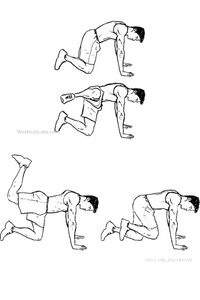
- Start on all fours with hands under the shoulders and knees under the hips. Brace your core & keep back in a neutral position
- Lift the knee up to your chest limiting the amount of rounding of the lower back.
- Keep the knee up and move the knee to the outside as far as possible, keeping the pelvis horizontal.
- Keep the knee there and rotate the hip inwards attempting to lift the foot higher than the knee. Try not to hike the pelvis up during this point in the exercise
- keep the leg up and bring it back behind you. Try not to over arch the back at this point in the exercise.
- Return to the start.
- This can also be performed in the reverse order
Hopefully by adding some of the exercises you will be able to reduce pain, move better and keep those hips and hamstrings happy – willpower not required
Looking for other fitness tips? Find more on the blog here
Learn more about Fired Up Fitness and how we can help you achieve your health and fitness goals in the comfort and safety of your own home by clicking here
Make sure to subscribe and listen to my podcast Willpower Not Required for more tips and ideas you can add into your day to live your life to the fittest! Listen on all podcast platforms or watch on YouTube

